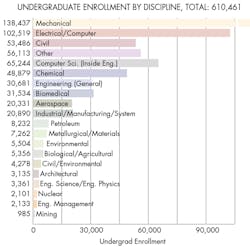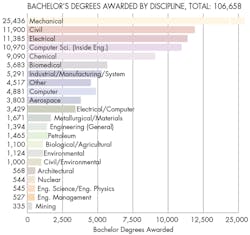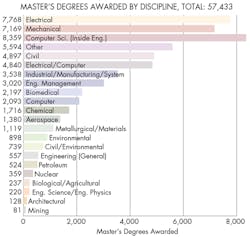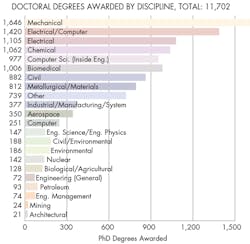What’s the Difference Between Engineering Degrees?
This file type includes high resolution graphics and schematics when applicable.
Today’s engineering education is an open playing field. Many engineers are being hired into positions that a few years ago would be considered a non-traditional profession. You can find engineers in human resource departments, in accounting firms, editorial staffs, and medical settings. You also see cross-engineering jobs where mechanical engineers, for example, work in civil engineering or electrical engineering. To understand the opportunities available to engineers, let us break down from the main disciplines to the concentrated ones the differences between them.
The Big Four
The following engineering disciplines account for 67% of all engineering bachelor degrees according to Dedicated Engineers.org: civil, computer, electrical, and mechanical engineering. According to the American Society for Engineering Education (ASEE), in the scholastic year 2014-15, 106,658 engineering bachelor degrees were awarded. Out of that total, 25,436 were in mechanical engineering, 11,900 were in civil engineering, 11,385 were in electrical engineering, and 10,970 were in computer engineering. Based on the same study, in the incoming freshman class of 2014-15, mechanical engineering saw the largest enrollment of 138,437, electrical/computer was second with 102,519, and civil placed third with 53,486.
Mechanical Engineering
Mechanical engineering is considered the broadest of engineering disciplines. This is due to the fact that it overlaps into many other existing engineering disciplines, which include civil and chemical engineering.
Areas of primary specialization are:
- Solid Mechanics: Analyzing the behaviors of solid bodies subjected to loads, stress, and/or vibration and to design and construct based on that analysis.
- Fluid Mechanics: Analyzing the behaviors of liquids and gases. Designing machinery and systems that include pumps, fans, turbines, and piping systems based on that knowledge.
- Thermodynamics: Analyzing the conversion of energy from one form to another. Design energy conversion devices and develop systems such as power plants, engines, heating, ventilations, and air condition.
According to Payscale.com, the average starting salary in 2016 for mechanical engineers is $62,527 and the mean annual salary for all mechanical engineers is $88,190 according to the Bureau of Labor Statistics (BLS) in 2015.
Civil Engineering
Civil engineers mainly focus on public works, infrastructures, and the construction of buildings and structures. Examples of public works and structures could be designing roads, dams, bridges, buildings, and canals. Due to their knowledge in materials and the environment, civil engineers are used to help analyze problems like coastal erosion or protect buildings from earthquakes.
Areas of primary specialization:
- Construction Management: Combining engineering knowledge with management skills and training to complete construction projects
- Geotechnical Engineering: Analysis of rock and soils to support engineering projects such as building foundations, earthen structures, dams, tunnels, etc.
- Surveying: Measuring and mapping the earth’s surface to support engineering designs and projects.
- Transportation Engineering: Designing types of transportation facilities and systems such as streets, highways, and other mass transit such as railroads and airports.
The average starting salary in 2016, according to Payscale.com was $55,995 and a mean annual salary of $87,940 according to BLS in 2015.
Electrical Engineering
Electrical engineering focuses on all things electrical or electronics-related. This includes electronic devices, electrical systems, electrical energy, etc. Electrical engineers design, develop, and with electrical systems. This could be to help develop efficient power methods and performance applications to help improve electronic system performance.
Areas of primary specialization are:
- Communications: The transmission and processing of information via either wires, cables, fiber optics, radio, wireless communications, satellites, etc.
- Digital Systems: Engineering geared toward digital-based communication and control systems.
- Electric Power: Generation, transmission, and/or distribution of electric power. Electric circuits deal with electricity movement but have no design-making or processing capability.
- Electronics: Engineering toward electronic devices and electrical circuits for producing, detecting, and controlling electrical signals for a variety of applications. These types of electronic circuits process signals to interpret or provide instruction to perform a designated task.
- Robotics and Control Systems: Controlling or performing automated processes via machines and electronic systems.
Starting salary for electrical engineers is $64,981 in 2016, according to Payscale.com. The mean annual salary in 2015 according to BLS in 2016 is $97,340.
Computer Engineering
Computer engineering bleeds into electrical engineering a little, but its main focus is to design and integrate computer systems, combining the worlds of hardware and software components. Computer engineering is an evolving field and those with this degree are among the most-sought-after engineering professionals today. With the important role computers and mobile devices are playing in our world, the demand for them is high.
Areas of primary specialization are:
- Hardware Engineering: Developing complex microprocessors, computer circuits, and printed circuit boards.
- Software Engineering: Writing, designing, developing, and testing software applications for a variety of businesses. The software can be for personal computers, industrial computers, or mobile devices. This also includes designing computer instruction sets and combining electronic or optical components to yield computing systems.
- Artificial Intelligence: Developing computers that can simulate learning and reasoning abilities. This includes advancements in computerized personal assistants like Siri or Alexa.
- Information Technology: Developing and managing information systems to support a business model or organization.
- Operating Systems and Networks: Designing and writing basic software for computers to use so they can supervise their own networks and communicate with each other independent of human input.
- Robotics: Construction of computer-controlled robots for performing repetitive industrial tasks.
- Software Applications: Applying computer software to help develop solutions for problems outside of the computer field environment such as in education or medicine. This would be the key example for the Internet of Things.
The starting salary for computer engineering in 2016 according to Payscale.com was $66,238 for hardware engineers and $68,510 for software engineers. The mean salary in 2015, according to BLS, was $114,970 and $108,760 for hardware and software engineering respectively.
Narrowing the Engineering Field
The next 20% of engineering degrees is comprised of aerospace, biomedical, chemical, and industrial/manufacturing engineering. According to the ASEE, 9,090 students graduated with a degree in chemical engineering, 5,683 with a degree in biomedical engineering, 5,291 with degree in industrial/manufacturing engineering, and 3,803 in aerospace engineering in the scholastic year of 2014-15.
Chemical Engineering
The focus of chemical engineering is applying chemistry in manufacturing based method for commercial production. This includes the production of fuels, plastics/polymers, pharmaceuticals, paper products, ceramics, electronic materials, industrial chemicals, and agricultural chemicals.
Areas of primary specialization are:
- Biotechnology: Engineering geared toward agricultural, food, and medical applications.
- Petroleum and Natural Gas: Refining crude oil and natural gas as a source of fuel for many motorized vehicles and devices.
- Polymers: Designing and focusing on the production of plastics, synthetic rubbers, fibers, films, and composite materials.
Starting salary according to Payscale.com is $67,006 in 2016 and the mean annual salary according to BLS is $103,960 in 2015.
Biomedical Engineering
Biomedical engineers focus on applying engineering applications to the fields of medicine and life sciences. Examples of this are artificial replacements like a hip or knee replacement, plastic components for hearts and veins, artificial limbs, and the use of electronics in the human body for monitoring purposes. As we get more specific in the field of engineering, we can see where the basis for that field comes from. Biomedical engineers overlap with mechanical, electrical, and chemical engineering depending on the specialty area.
Areas of primary specialty are:
- Biomaterials: Designing of living tissue and artificial materials for implants.
- Biomechanics: Designing implants or artificial tools based in mechanical principals to help solve medical problems or handicaps, i.e., artificial limbs and implants.
- Biotechnology: Development and production of pharmaceutical products.
- Medical Devices and Equipment: Development of diagnostic equipment like X-rays, CAT scans, MRIs, etc.
Starting salary according to Payscale.com is $61,288 in 2016 and the mean annual salary according to BLS is $91,230 in 2015.
Industrial/Manufacturing Engineering
Industrial/Manufacturing Engineers focus on how to organize, implement, and operate production factors in the most efficient manner possible. This involves the development of processes involving materials, equipment, people, information, and energy. The world of the Internet of Things is greatly affecting the role of the industrial engineer and how the scope of their profession.
Areas of primary specialty are:
- Ergonomics: Developing a better workplace environment to accommodate human abilities and behaviors to yield efficient operations with fewer injuries or accidents.
- Facility Design: Designing the work environment to operate efficiently while accommodating workers, equipment, robotics, moving vehicles, products, etc.
- Quality control: Analysis based on sampling products to assess and maintain quality of yield and services.
- Work Design and Worker Productivity: Defining the jobs of workers and setting work standards to optimize the facility work methods.
Starting salary according to Payscale.com is $63,509 in 2016 and the mean annual salary according to BLS is $86,990 in 2015.
Aerospace Engineering
The focus of aerospace engineering deals with flight vehicles and systems for both space flight and sub-space flight. This includes airplanes, helicopters, missiles, rockets, and spacecraft. Aerospace engineers also work on land vehicles as the principles of aerodynamics apply to both.
Areas of primary specialty are:
- Aerodynamics: The study and designing of external surfaces to move efficiently through fluids.
- Structural Design and Material Selection: Designing parts based with the specific materials based on the required operation. Examples would be ceramics on spacecraft vehicles for heat resistance or fiberglass on racing cars for weight savings.
- Propulsion Systems: Designing with fuel mixtures or chemicals for propelling objects into the atmosphere or space. Examples would be solid-state chemical rockets or fuel mixtures for space shuttle rockets.
Starting salary according to Payscale.com is $78,544 in 2016 and the mean annual salary according to BLS is $110,570 in 2015.
Smaller and Specialty Disciplines
The list of engineering degrees goes on and on. You have many subsets of engineering; for example, petroleum engineering and materials engineering could be considered subsets of chemical engineering, while many aerospace engineers start off as mechanical engineers first. Environmental engineers can be divided even further down to agricultural, mining, or ocean engineers. This smaller subset of engineering disciplines accounts for 15% of all engineering degrees available. The trend appears to be that the more specific engineers’ degrees become, the higher in salary they are and the smaller the amount of employed engineers in the field becomes.
This file type includes high resolution graphics and schematics when applicable.







